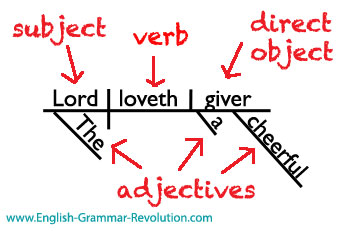Download your free grammar guide here.
Download your free grammar guide here.
Take this 1912 grammar test for eighth-graders!
1912 Grammar Test for Eighth-Graders
- Home
- Grammar Quizzes
- 1912 Grammar Test
Would you pass this grammar test that eighth-graders were given in 1912? I'm not sure that I would. :) They really knew their stuff! Take the test and see for yourself. You'll find the answers below.

Take The Test
- 1. How many parts of speech are there? Define each.
2. Define proper noun; common noun. Name the properties of a noun.
3. What is a personal pronoun? Decline I.
4. What properties have verbs?
5. "William struck James." Change the voice of the verb.
6. Adjectives have how many degrees of comparison? Compare good; wise; beautiful.
7. Diagram: The Lord loveth a cheerful giver.
8. Parse all the words in the following sentences: John ran over the bridge. Helen's parents love her.
This grammar section is just one of the subjects that eighth-graders were tested on. You can see the rest of the test here.
Check Your Answers Here
I don't have an official copy of the answers for this test, but I do know grammar, so here are my unofficial answers.
1. How many parts of speech are there? Define each.
There are eight parts of speech.
-
1. Nouns name people, places, things, or ideas.
2. Pronouns take the place of nouns.
3. Adjectives describe nouns and pronouns.
4. Verbs name actions or states of being.
5. Adverbs modify verbs, adjectives, and other adverbs.
6. Prepositions show the relationship between a noun or a pronoun and some other word in the rest of the sentence.
7. Conjunctions join two or more words, phrases, or clauses.
8. Interjections show excitement or emotion. They are not grammatically related to the rest of the sentence.
Learn or teach grammar with our Get Smart Grammar Program!

2. Define proper noun; common noun. Name the properties of a noun.
Properties is referring to what characteristics or attributes nouns have.
Proper nouns name specific people, places, things, or ideas.
Common nouns name non-specific people, places, things, or ideas.
person, city, company, dog
Properties of a Noun
- Case (subject, object, possessive)
- Gender (masculine, feminine, neuter)
- Number (singular, plural)
- Person (1st person, 2nd person, 3rd person)
Learn about common nouns and proper nouns here.
3. What is a personal pronoun? Decline I.
Personal pronouns take the place of common and proper nouns.
Nouns, pronouns, and adjectives have different forms depending on the number, case, and gender of the word. Decline means to state these different forms.
Personal pronouns have three modified forms based on the purpose that the pronoun has in the sentence.
I've added an example sentence for you after each declension. (Isn't that a fancy word?)
I (subject)
me (object)
mine (possessive)
4. What properties have verbs?
Isn't this question worded in an interesting way? Properties here is referring to what characteristics or attributes verbs have.
Verbs have five properties.
- 1. Person (1st person, 2nd person, 3rd person)
2. Number (singular or plural)
3. Tense (indicates time)
4. Voice (active, passive)
5. Mood (indicative, subjunctive, imperative)
Learn about verb tenses here.
5. "William struck James."
Change the voice of the verb.
This sentence is written in the active voice. This means that the subject is performing the action.
Changing the voice means changing this sentence into the passive voice. After we do that, the subject will be acted upon. You can learn about active voice and passive voice here.
That sentence is in the active voice.
That sentence is in the passive voice.
6. Adjectives have how many degrees of comparison?
Compare good; wise; beautiful.
Learn about comparative & superlative adjectives here.
Adjectives (and adverbs) can have different degrees. That means that things can have more or less of an adjective's quality.
Adjectives (and adverbs) have three forms, but only two of them show comparison.
The two forms used to show comparison are superlative and comparative. (The third form is positive.)
The positive form of an adjective is the one we use when we are not comparing things.
The weather is hot.
We use comparative forms when we are comparing two things.
The weather in Tahiti is hotter than the weather in California.
We use superlative forms when we are comparing three or more things.
The Sahara Desert's weather is the hottest.
| Positive | Comparative | Superlative |
| good | better | best |
| wise | wiser | wisest |
| beautiful | more beautiful | most beautiful |
7. Diagram:
The Lord loveth a cheerful giver.
Sentence diagrams show you how the words in a sentence are related to each other. They are pretty cool.


Learn more about diagramming sentences here.
8. Parse all the words in the following sentences: John ran over the bridge. Helen's parents love her.
John ran over the bridge.
John is a proper noun. It is the subject of the sentence.
Ran is an intransitive verb.
Over the bridge is a prepositional phrase modifying the verb. It answers the question, "Where did John run?"
Over is a preposition; bridge is the object of the preposition, and the is an adjective telling us which bridge.
Helen's parents love her.
Parents is a common noun. It is the subject of the sentence.
Helen's is a possessive noun functioning as an adjective modifying parents.
Love is a transitive verb.
Her is an objective pronoun. It is the direct object of the verb love.
Learn or teach grammar with our Get Smart Grammar Program!


Hello! I'm Elizabeth O'Brien, and my goal is to get you jazzed about grammar.
I'm a recent college graduate who never learned sentence diagramming in school, but I decided to try my hand at it as a way to improve my writing. It definitely changes the way that I see our language, and it has proven an invaluable groundwork for learning more abstract techniques of writing effectively.
- Cameron
This is original content from https://www.english-grammar-revolution.com/1912-grammar-test-answers.html
Our Free Guide Gives You A Fun Way
To Teach And Learn The Basics v

Elizabeth O'Brien is the creator of Grammar Revolution.
Her lessons are guaranteed to give you more confidence in your communication skills and make you smile. :)

